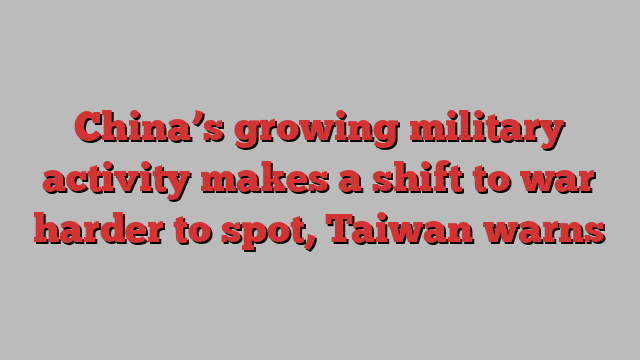
Unlock the Editor’s Digest for free
Roula Khalaf, Editor of the FT, selects her favourite stories in this weekly newsletter.
Taiwan’s defence minister has warned that China’s growing military activity will make it more difficult to spot harbingers of an attack on his country.
Wellington Koo said Taiwan needed to test its ability to respond to “a potential sudden contingency” and that his country’s reaction time to an emergency “cannot be as long as we would have imagined in the past”.
“We have to think about how we differentiate between peacetime and wartime,” Koo told reporters. “The scale of [China’s military] activity is getting larger and larger, and so it is harder to discern when they might be shifting from training to a large exercise, and from an exercise to war.”
His remarks show the challenge that China’s gradual expansion of military moves below the threshold of war poses to Taiwan’s defences. They come as China’s People’s Liberation Army has ratcheted up patrols and drills near Taiwan to unprecedented levels since President Lai Ching-te took office in May.
The Chinese Communist party has denounced Lai, whose Democratic Progressive party refuses to describe Taiwan as part of China, as a “dangerous separatist”.
Taiwan’s military has registered a record 2,076 PLA incursions this year into its air defence identification zone — a self-declared buffer zone just outside its sovereign airspace.
Koo spoke after a Chinese aircraft carrier group passed through waters near Taiwan’s northern tip early on Wednesday. The group also sailed through a narrow strait between two of Japan’s southernmost islands, entering the Japanese contiguous zone — an area adjacent to its territorial waters — for the first time.
Earlier this month, the PLA conducted its largest amphibious landing drills on China’s south-east coast opposite Taiwan, an annual exercise widely seen as practising skills for invading Taiwan.
China has also been deploying increasing numbers of non-military government ships such as coastguard, marine research and maritime safety vessels in waters around Taiwan. Defence experts believe the missions gather ocean data for submarine warfare and simulate coercive measures that could be used in a blockade.
Koo said Taiwan’s armed forces needed to use its observations of PLA behaviour to build scenarios for its own exercises.
Taipei is under pressure to show determination to strengthen its defences, amid concerns that the US could become less committed to supporting the country’s security if Donald Trump wins the US presidential election.
Under the Taiwan Relations Act, Washington considers any effort to determine Taiwan’s future by non-peaceful means as an issue of grave concern to the US. The law commits Washington to providing Taiwan with defensive weapons and to maintaining US capacity to resist coercion that would jeopardise Taiwan’s security.
However Trump recently said that Taiwan should pay the US for defence because “we’re no different than an insurance company [and] Taiwan doesn’t give us anything”.
While Lai’s cabinet has proposed a 7.7 per cent increase in defence spending to NT$647bn for next year, the figure marks a slight drop in terms of gross domestic product, from 2.5 per cent this year to 2.45 per cent.
Koo, the head of the National Security Council under Lai’s predecessor Tsai Ing-wen, took office in May and has pushed the country’s armed forces to make training more realistic and cut bureaucracy.